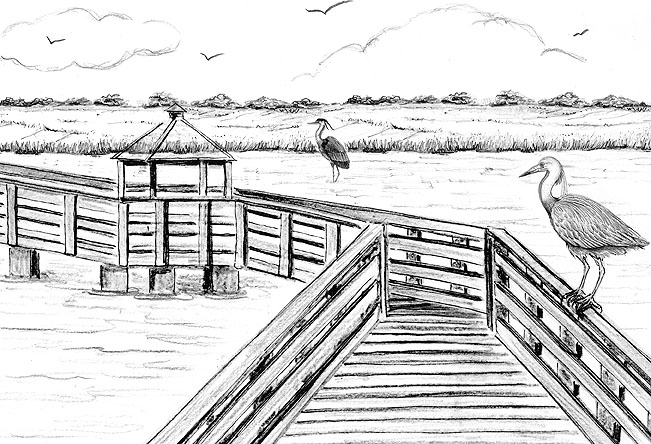
More on birding in Florida.
Last week Betsy (from Sandwich MA) asked about bird watching in Florida. In particular, she wanted to know about Sanibel Island’s Ding Darling National Wildlife Refuge. I told Betsy that Ding Darling is a fine place for birding, but there are other places that maybe even better. And since I too was headed to Florida, I told her I would personally check out other locations and report back. Well, I did what I promised. Last week, my son Casey and I visited four noted birding spots on Florida’s east coast and here’s my report. How exciting.
The first place we visited was Merritt Island National Wildlife Refuge, near Cape Canaveral. I want to tell you, this place rocks. I like it better than Ding Darling. That may be considered blasphemy to the ears of most birders, but it’s true. I saw a lot more birds than I typically do at Ding Darling, plus it’s much easier to get to. It’s just off of I-95, near the quiet town of Titusville, which doesn’t have all the traffic that Sanibel has. Plus, the bridge to Merritt Island is free. That’s right, free. Not six bucks like the one to Sanibel. (I may never get over that.) Like Ding Darling, Merritt Island has a wildlife drive (seven miles of one-way driving) called Black Point Wildlife Drive, which also costs five dollars. Unlike Ding Darling, however, there is no visitor center or restrooms at entrance of the drive. I repeat, no restrooms. Keep that in mind or you could end up dealing with the bushes and poison ivy like I had to. (It turns out there are restrooms near the end of the drive, but they appeared way too late to help me.)
Merritt Island has all the herons, egrets and ibis you would expect to see in Florida, plus those freaky-headed Wood Storks and the eye-catching Roseate Spoonbills. In addition, there was a large assortment of wintering waterfowl including grebes, teal, mergansers, shovelers and around four gazillion American Coots. Also Ospreys, harriers and vultures constantly crisscrossed the skies above. (What is with Florida and all the vultures?). There are, of course, other creatures to see besides birds. Gators and river otters make regular appearances along the drive and on this one particular day we saw a huge bear feeding out in the marsh. I started yelling, “A bear! A bear!” At least I thought it was a bear until it lifted up its head. That’s when our bear turned out to be an enormous, black feral pig. Oops. Apparently, Florida bears don’t have flat noses and curly tails.
What’s nice about visiting Merritt Island is if you get tired of nature, the Kennedy Space Center is only a few miles away. There is also a manatee observation deck just down the road. We didn’t go there. I was afraid if I saw a manatee I’d start yelling, “A bear! A bear!” or think it was a swimming pig. Important note: Remember, Merritt Island’s Black Point wildlife drive is just over the bridge, east of Titusville. Don’t trust Google maps on this one. If you do you could end up like we did, in the sketchy, remote northern section of the refuge, where the birds have more teeth than the people.
A few days later, and farther down the coast, Casey and I stopped by the Loxahatchee National Wildlife Refuge near Boca Raton. After paying the obligatory five bucks, we drove to the visitor center for a map and some suggestions from the staff. The lady behind the desk sounded like she was from Dutchess County, NY (just like everybody in Florida this time of year), but she made us feel very welcomed. This refuge is a great place to see the extremely specialized Snail Kites. From a distance Snail Kites look very much like harriers (marsh hawks) as they search for their specific food of choice, which is snails. We watched as a kite competently plucked the rather large snails out of the marsh and then flew to its favorite feeding post and skillfully removed the snail-meat from the shells. Eating live snails seemed pretty gross to us, but a nearby birder from France was salivating.
A few short miles from Loxahatchee are two very good birding spots, near the town of Delray Beach that two of my favorite customers told me about. Hidden among Delray Beach’s endless country clubs and gated communities is Wakodahatchee Wetlands (good luck trying to pronounce it). Birders and photographers will love this place, especially because it’s free. There is absolutely no entrance fee or pricey bridge to cross. You don’t even need binoculars because the birds are only a few feet away from the elevated boardwalk. We got great looks at colorful Black-bellied Whistling Ducks and Green Herons, as well as nesting Anhingas and Great Blue Herons, both of which were feeding fish to their super-ugly babies.
Literally around the block from the Wakodahatchee Wetlands is the beautiful Green Cay Nature Center. This wonderful place is also free and offers great bird viewing from elevated boardwalks. In addition to a whole host of other birds, we saw birds with the best names in the bird world, including Soras, Limpkins, bitterns and Purple Gallinules. (If there isn’t a punk band with the name “Purple Gallinules,” there should be.)
If you are on Florida’s west coast, Betsy, then by all means spend a day at Ding Darling. But if you find yourself in the east, you really should visit a few of the places I’ve just mentioned. We found great birds in all of them. And in one place in particular we even saw a black bear with a flat nose and a curly tail. That’s a rare creature indeed.